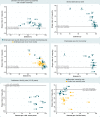SDG3-related inequalities in women's, children's and adolescents' health: an SDG monitoring baseline for Latin America and the Caribbean using national cross-sectional surveys
- PMID: 34413102
- PMCID: PMC8378377
- DOI: 10.1136/bmjopen-2020-047779
SDG3-related inequalities in women's, children's and adolescents' health: an SDG monitoring baseline for Latin America and the Caribbean using national cross-sectional surveys
Abstract
Objectives: Latin America and the Caribbean (LAC) countries have made important progress towards achieving the Sustainable Development Goal (SDG) targets related to health (SDG3) at the national level. However, vast within-country health inequalities remain. We present a baseline of health inequalities in the region, against which progress towards the SDGs can be monitored.
Setting: We studied 21 countries in LAC using data from Demographic and Health Surveys and Multiple Indicator Cluster Survey carried out from 2011 to 2016 PARTICIPANTS: The surveys collect nationally representative data on women and children using multistage sampling. In total, 288 207 women and 195 092 children made part of the surveys in the 21 countries.
Outcome measures: Five health intervention indicators were studied, related to reproductive and maternal health, along with adolescent fertility and neonatal and under-five mortality rates. Inequalities in these indicators were assessed through absolute and relative measures.
Results: In most countries, subnational geographical health gradients were observed for nearly all women, child, and adolescent (WCA) indicators. Coverage of key interventions was higher in urban areas and among the richest, compared with rural areas and poorer quintiles. Analyses by woman's age showed that coverage was lower in adolescent girls than older women for family planning indicators. Pro-urban and pro-rich inequalities were also seen for mortality in most countries.
Conclusions: Regional averages hide important health inequalities between countries, but national estimates hide still greater inequalities between subgroups of women, children and adolescents. To achieve the SDG3 targets and leave no one behind, it is essential to close health inequality gaps within as well as between countries.
Keywords: community child health; epidemiology; health policy; public health.
© Author(s) (or their employer(s)) 2021. Re-use permitted under CC BY-NC. No commercial re-use. See rights and permissions. Published by BMJ.
Conflict of interest statement
Competing interests: None declared.
Figures



References
-
- United Nations Statistics Division (UNSD) . Sdg indicators global indicator framework for the sustainable development goals and targets of the 2030 agenda for sustainable development, 2018. Available: https://unstats.un.org/sdgs/indicators/Global%20Indicator%20Framework%20... [Accessed 26 Oct 2020].
-
- United Nations Statistics Division (UNSD) . The Sustainable Development Report Goals 2016. Leaving no one behind [Web Page], 2016. Available: https://unstats.un.org/sdgs/report/2016/leaving-no-one-behind [Accessed 26 Oct 2020].
-
- United Nations Statistics Division (UNSD) . Targets and indicators [Web Page], 2016. Available: https://unstats.un.org/sdgs/indicators/indicators-list/ [Accessed 26 Oct 2020].
-
- Economic Commission for Latin America and the Caribbean (ECLAC) . Social Panorama of Latin America, 2019 (LC/PUB.2019/22-P/Rev.1). Santiago: ECLAC, 2019.
Publication types
MeSH terms
LinkOut - more resources
Full Text Sources
Medical
